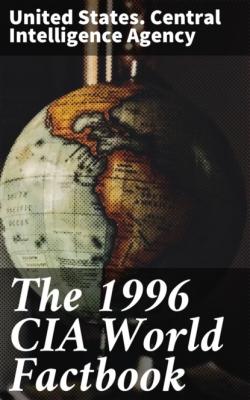The 1996 CIA World Factbook. United States. Central Intelligence Agency
Читать онлайн.| Название | The 1996 CIA World Factbook |
|---|---|
| Автор произведения | United States. Central Intelligence Agency |
| Жанр | Социология |
| Серия | |
| Издательство | Социология |
| Год выпуска | 0 |
| isbn | 4057664582324 |
Branches: Army, Air Force, National Gendarmerie, National Police,
People's Militia
Manpower availability: males age 15–49: 2,149,485 males fit for military service: 1,101,184 (1996 est.)
Defense expenditures: exchange rate conversion - $104 million, 6.4% of GDP (1994)
======================================================================
@Burma——
Map—
Location: 22 00 N, 98 00 E—Southeastern Asia, bordering the
Andaman Sea and the Bay of Bengal, between Bangladesh and Thailand
Flag——
Description: red with a blue rectangle in the upper hoist-side corner bearing, all in white, 14 five-pointed stars encircling a cogwheel containing a stalk of rice; the 14 stars represent the 14 administrative divisions
Geography————
Location: Southeastern Asia, bordering the Andaman Sea and the Bay
of Bengal, between Bangladesh and Thailand
Geographic coordinates: 22 00 N, 98 00 E
Map references: Southeast Asia
Area:
total area: 678,500 sq km
land area: 657,740 sq km
comparative area: slightly smaller than Texas
Land boundaries:
total: 5,876 km
border countries: Bangladesh 193 km, China 2,185 km, India 1,463 km,
Laos 235 km, Thailand 1,800 km
Coastline: 1,930 km
Maritime claims:
contiguous zone: 24 nm
continental shelf: 200 nm or to the edge of the continental margin
exclusive economic zone: 200 nm
territorial sea: 12 nm
International disputes: none
Climate: tropical monsoon; cloudy, rainy, hot, humid summers (southwest monsoon, June to September); less cloudy, scant rainfall, mild temperatures, lower humidity during winter (northeast monsoon, December to April)
Terrain: central lowlands ringed by steep, rugged highlands
lowest point: Andaman Sea 0 m
highest point: Hkakabo Razi 5,881 m
Natural resources: petroleum, timber, tin, antimony, zinc, copper,
tungsten, lead, coal, some marble, limestone, precious stones,
natural gas
Land use:
arable land: 15%
permanent crops: 1%
meadows and pastures: 1%
forest and woodland: 49%
other: 34%
Irrigated land: 10,180 sq km (1989)
Environment:
current issues: deforestation; industrial pollution of air, soil,
and water; inadequate sanitation and water treatment contribute to
disease
natural hazards: destructive earthquakes and cyclones; flooding and
landslides common during rainy season (June to September); periodic
droughts
international agreements: party to - Biodiversity, Climate Change,
Nuclear Test Ban, Ozone Layer Protection, Ship Pollution, Tropical
Timber 83; signed, but not ratified - Law of the Sea, Tropical
Timber 94
Geographic note: strategic location near major Indian Ocean
shipping lanes
People———
Population: 45,975,625 (July 1996 est.)
Age structure:
0–14 years: 37% (male 8,637,102; female 8,308,282)
15–64 years: 59% (male 13,577,232; female 13,571,312)
65 years and over: 4% (male 853,403; female 1,028,294) (July 1996
est.)
Population growth rate: 1.84% (1996 est.)
Birth rate: 30.01 births/1,000 population (1996 est.)
Death rate: 11.66 deaths/1,000 population (1996 est.)
Net migration rate: 0 migrant(s)/1,000 population (1996 est.)
Sex ratio:
at birth: 1.06 male(s)/female
under 15 years: 1.04 male(s)/female
15–64 years: 1 male(s)/female
65 years and over: 0.83 male(s)/female
all ages: 1.01 male(s)/female (1996 est.)
Infant mortality rate: 80.7 deaths/1,000 live births (1996 est.)
Life expectancy at birth: total population: 56.14 years male: 54.46 years female: 57.92 years (1996 est.)
Total fertility rate: 3.83 children born/woman (1996 est.)
Nationality:
noun: Burmese (singular and plural)
adjective: Burmese
Ethnic divisions: Burman 68%, Shan 9%, Karen 7%, Rakhine 4%,
Chinese 3%, Mon 2%, Indian 2%, other 5%
Religions: Buddhist 89%, Christian 4% (Baptist 3%, Roman Catholic
1%), Muslim 4%, animist beliefs 1%, other 2%
Languages: Burmese, minority ethnic groups have their own languages
Literacy: age 15 and over can read and write (1995 est.)
total population: 83.1%
male: 88.7%
female: 77.7%
Government—————
Name of country:
conventional long form: Union of Burma
conventional short form: Burma
local long form: Pyidaungzu Myanma Naingngandaw (translated by the
US Government as Union of Myanma and by the Burmese as Union of
Myanmar)
local short form: Myanma Naingngandaw
former: Socialist Republic of the Union of Burma
Data code: BM
Type of government: military regime
Capital: Rangoon (regime refers to the capital as Yangon)
Administrative divisions: 7 divisions* (yin-mya, singular - yin)
and 7 states (pyine-mya, singular - pyine); Chin State, Ayeyarwady*,
Bago*, Kachin State, Kayin State, Kayah State, Magway*, Mandalay*,
Mon State, Rakhine State, Sagaing*, Shan State, Tanintharyi*, Yangon*
Independence: 4 January 1948 (from UK)
National holiday: Independence Day, 4 January (1948)
Constitution: 3 January 1974 (suspended since 18 September 1988); national convention started on 9 January 1993 to draft a new constitution; chapter headings and three of 15 sections have been approved
Legal system: does not accept compulsory ICJ jurisdiction
Suffrage:
